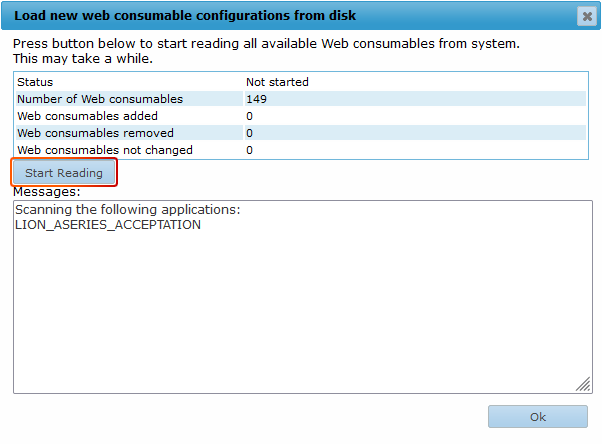Web Consumables
Under this tab, all available Web Consumables of the AMT environment can be added, configured, and displayed. A filter can be applied to display the Web Consumables from one or more applications.
Adding Web Consumables
To add new Web Consumables to the environment, first select the Read all webconsumable dlls from system button.

In the new window that opens, select the Start Reading button.

The Web Consumables that have been added can then be found in the list. To view a Web Consumable, select one from the list and select the View button.
| It is necessary to re-read a Web Consumable if new ports were added in the AMT Developer Studio before it is possible to edit its settings. |
Configuring Web Consumables
By selecting a Web Consumable and then selecting the Edit button, its options can be configured. Options, such as enabling logging, are available only from this menu.

The following settings are available:
- Application: The name of the application of which the Web Consumable is a part.
- Web consumable name: The name of the Web Consumable as set in the AMT Developer Studio.
- User: The username to be used together with a password as credentials for authentication.
- Password: The password to be used together with a username as credentials for authentication.
- Send authorization header: If enabled, requests to the Web Consumable will be authenticated using the user's credentials.
- Concurrent calls: The number of concurrent requests allowed to be made to the Web Consumable service.
- Enable logging: Enables writing logs from the web service to a log file. Log files
are located
in the directories as set in the Basepaths Logging
path settings in
the Control Center.
- If the web service is used in a report, the messages will be written to the Batch.log file.
- If the web service is used in a form, logs will be written to the application service agent file named
<Application service>_AGENT_<Agent number>.log
- Endpoint address: The endpoint address of the web service.
- Security mode: Available values are None
(default) and Transport.
- None: No security is used.
- Transport: The service is secured with HTTPS and must be configured with SSL
certificates.
- Client credential type:
 This setting is only functional if Security mode is set to
Transport. Available values are None, Windows
(default) and Ntlm.
This setting is only functional if Security mode is set to
Transport. Available values are None, Windows
(default) and Ntlm.- None: Specifies anonymous authentication.
 If Security
mode is set to none, Client credential type is also set to
none.
If Security
mode is set to none, Client credential type is also set to
none. - Windows: This option uses built-in Windows authentication.
- Ntlm: This option uses Ntlm (NT Lan Manager) authentication.
- None: Specifies anonymous authentication.
- Max buffer size: The maximum size, in bytes, for a buffer that receives messages from the channel.
- Max buffer pool size: The maximum size, in bytes, that is allocated for use by the manager of the message buffers that receive messages from the channel.
- Max received message
size: The maximum size, in bytes, for a message that can be received on a channel configured
with this binding.
If the value for Max buffer size, Max buffer pool size, and Max received message size is set to 0, then the default .NET framework values are used.
| The default settings of a Web Consumable can be restored by removing the service from the list with the Remove button and then re-read by selecting the Read all webconsumable dlls from system button. |
